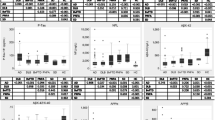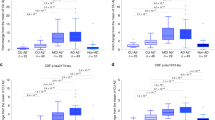Abstract
In 31 patients with probable Alzheimer’s disease (AD), 19 with probable vascular dementia (VaD) and 20 with Possible AD and Possible VaD, cerebrospinal fluid (CSF) tau levels hyperphosphorylated at threonine 181 (Ptau) were measured by ELISA. Thirty-six age-matched subjects were used as controls. The severity of the cognitive decline was assessed at the time of CSF analysis and after a 12-month follow-up. The groups had comparable age, degree of cognitive impairment and disease duration; these parameters were not related to P-tau levels. P-tau discriminated between demented patients and controls, but no significant difference emerged between AD and the other groups. By contrast, higher P-tau values were found to predict, independently of the clinical diagnosis, a more rapid evolution of cognitive decline. Whether these findings are due to a lack of CSF P-tau specificity or to the low reliability of clinical and radiological criteria remains unclear. P-tau may be useful in the evaluation of disease evolution, by predicting the rate of cognitive decline.
Similar content being viewed by others
References
Ferri CP, Prince M, Brayne C et al (2005) Global prevalence of dementia: a Delphi consensus study. Lancet 366:2112–2117
McKhann G, Drachman D, Folstein M et al (1984) Clinical diagnosis of Alzheimer’s disease: report of the NINCDS-ADRDA Work Group under the auspices of Department of health and human services task force on Alzheimer’s disease. Neurology 34:939–944
Goedert M (1993) Tau protein and the neurofibrillary pathology of Alzheimer’s disease. Trends Neurosci 16:460–465
Buée L, Bussiere T, Buée-Scherrer V et al (2000) Tau protein isoforms, phosphorylation and role in neurodegenerative disorders. Brain Res Rev 33:95–130
Augustinack JC, Schneider A, Mandelkow EM, Hyman BT (2002) Specific tau phophorylation sites correlate with severity of neuronal cytopathology in Alzheimer’s disease. Acta Neuropathol 103:26–35
Andreasen N, Vanmechelen E, Vanderstichele H et al (2003) Cerebrospinal fluid levels of total-Tau, phospho-Tau and A 42 predicts development of Alzheimer’s disease in patients with mild cognitive impairment. Acta Neurol Scand 107[Suppl 179]:47–51
Andreasen N, Blennow K (2005) CSF biomarkers for mild cognitive impairment and early Alzheimer’s disease. Clin Neurol Neurosurg 107:165–173
Blennow K, Wallin A, Ågren H et al (1995) Tau protein in cerebrospinal fluid: a biochemical diagnostic marker for axonal degeneration in Alzheimer’s disease? Mol Chem Neuropathol 26:231–245
Hulstaert F, Blennow K, Ivanoiu A et al (1999) Improved discrimination of AD patients using beta-amyloid(1-42) and tau levels in CSF. Neurology 52:1555–1562
Andreasen N, Hesse C, Davidsson P et al (1999) Cerebrospinal fluid -amyloid(1–42) in Alzheimer’s disease: differences between early- and late-onset alzheimer disease and stability during the course of disease. Arch Neurol 56:673–680
Otto M, Wiltfang J, Tumani H et al (1997) Elevated levels of tauprotein in cerebrospinal fluid of patients with Creutzfeldt-Jakob disease. Neurosci Lett 225:210–212
Blennow K, Hampel H (2003) CSF markers for incipient Alzheimer’s disease. Lancet Neurol 2:605–613
Hampel H, Buerger K, Zinkoswski R et al (2004) Measurement of phosphorylated tau epitopes in the differential diagnosis of Alzheimer’s Disease: a comparative cerebrospinal fluid study. Arch Gen Psychiatry 61:95–102
Bibl M, Mollenhauer B, Esselmann H et al (2008) Cerebrospinal fluid neurochemical phenotypes in vascular dementias: original data and mini-review. Dement Geriatr Cogn Disord 25:256–265
Roman GC, Tatemichi TK, Erkinjuntti T et al (1993) Vascular dementia: diagnostic criteria for research studies. Report of the NINDS-AIREN International Workshop. Neurology 43:250–260
Folstein ME, Folstein SE, McHugh PR (1975) Mini-mental State. A practical method for grading the cognitive state of patients for the clinician. J Psychiatry Res 12:189–198
Tibbling G, Link H, Ohman S (1977) Principles of albumin and IgG analyses in neurological disorders. Establishment of reference values. Scand J Clin Lab Investig 37:385–390
Vanmechelen E, Vanderstichele H, Davidsson P et al (2000) Quantification of tau phosphorylated at threonine 181 in human cerebrospinal fluid: a sandwich ELISA with a synthetic phosphopeptide for standardization. Neurosci Lett 285:49–52
Itoh N, Arai H, Urakami K et al (2001) Large-scale, multicenter study of cerebrospinal fluid tau protein phosphorylated at serine 199 for the antemortem diagnosis of Alzheimer’s disease. Ann Neurol 50:150–156
Maddalena A, Papassotiropoulos A, Muller-Tillmanns B et al (2003) Biochemical diagnosis of Alzheimer disease by measuring the cerebrospinal fluid ratio of phosphorylated tau protein to betaamyloid peptide 42. Arch Neurol 60:1202–1206
Buerger K, Zinkowski R, Teipel SJ et al (2002) Differential diagnosis of Alzheimer’s disease with cerebrospinal fluid levels of tau protein phosphorylated at threonine 231. Arch Neurol 59:1267–1272
Sjögren M, Davidsson P, Tullberg M et al (2001) Both total and hyperphosphorylated tau are increased in Alzheimer’s disease. J Neurol Neurosurg Psychiatry 70:624–630
Jellinger KA (1996) Diagnostic accuracy of Alzheimer’s disease. A clinicopathological study. Acta Neuropathol 91:219–220
Holmes C, Cairns N, Lantos P, Mann A (1999) Validity of current clinical criteria for Alzheimer’s disease, vascular dementia and dementia with Lewy bodies. Br J Psychiatry 174:45–50
Lim A, Tsuang D, Kukull W et al (1999) Clinico-neuropathological correlation of Alzheimer’s disease in a community-based case series. J Am Geriatr Soc 47:564–569
Jellinger KA (2008) The pathology of “vascular dementia”: a critical update. J Alzheimers Dis 14:107–123
Knopman DS, DeKosky ST, Cummings JL et al (2001) Practice parameter: diagnosis of dementia (an evidence-based review): Report of the Quality Standards Subcommittee of the American Academy of Neurology. Neurology 56:1143–1153
Walhund L, Blennow K (2003) Cerebrospinal fluid biomarkers for disease stage and intensity in cognitively impaired patients. Neurosci Lett 339:99–102
De Leon MJ, Desanti S, Zinkowski R et al (2006) Longitudinal CSF and MRI biomarkers improve the diagnosis of mild cognitive impairment. Neurobiol Aging 3:394–401
Wallin AK, Blennow K, Andreasen N, Minthon L (2006) CSF biomarkers for Alzheimer’s disease: levels of beta-amyloid, tau, phosphorylated tau relate to clinical symptoms and survival. Dement Geriatr Cogn Disord 3:131–138
Author information
Authors and Affiliations
Corresponding author
Rights and permissions
About this article
Cite this article
Ravaglia, S., Bini, P., Sinforiani, E. et al. Cerebrospinal fluid levels of tau phosphorylated at threonine 181 in patients with Alzheimer’s disease and vascular dementia. Neurol Sci 29, 417–423 (2008). https://doi.org/10.1007/s10072-008-1023-1
Received:
Accepted:
Published:
Issue Date:
DOI: https://doi.org/10.1007/s10072-008-1023-1




